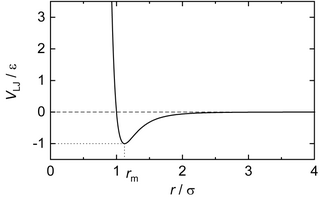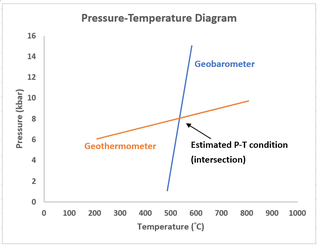Related Research Articles

Computational chemistry is a branch of chemistry that uses computer simulations to assist in solving chemical problems. It uses methods of theoretical chemistry incorporated into computer programs to calculate the structures and properties of molecules, groups of molecules, and solids. The importance of this subject stems from the fact that, with the exception of some relatively recent findings related to the hydrogen molecular ion, achieving an accurate quantum mechanical depiction of chemical systems analytically, or in a closed form, is not feasible. The complexity inherent in the many-body problem exacerbates the challenge of providing detailed descriptions of quantum mechanical systems. While computational results normally complement information obtained by chemical experiments, it can occasionally predict unobserved chemical phenomena.
In physics, statistical mechanics is a mathematical framework that applies statistical methods and probability theory to large assemblies of microscopic entities. Sometimes called statistical physics or statistical thermodynamics, its applications include many problems in the fields of physics, biology, chemistry, neuroscience, computer science, information theory and sociology. Its main purpose is to clarify the properties of matter in aggregate, in terms of physical laws governing atomic motion.

A phase diagram in physical chemistry, engineering, mineralogy, and materials science is a type of chart used to show conditions at which thermodynamically distinct phases occur and coexist at equilibrium.

In computational chemistry, molecular physics, and physical chemistry, the Lennard-Jones potential is an intermolecular pair potential. Out of all the intermolecular potentials, the Lennard-Jones potential is probably the one that has been the most extensively studied. It is considered an archetype model for simple yet realistic intermolecular interactions. The Lennard-Jones potential is often used as a building block in molecular models for more complex substances. Many studies of an idealized "Lennard-Jones fluid" use the potential to understand the physical nature of the state of fluids.

Molecular modelling encompasses all methods, theoretical and computational, used to model or mimic the behaviour of molecules. The methods are used in the fields of computational chemistry, drug design, computational biology and materials science to study molecular systems ranging from small chemical systems to large biological molecules and material assemblies. The simplest calculations can be performed by hand, but inevitably computers are required to perform molecular modelling of any reasonably sized system. The common feature of molecular modelling methods is the atomistic level description of the molecular systems. This may include treating atoms as the smallest individual unit, or explicitly modelling protons and neutrons with its quarks, anti-quarks and gluons and electrons with its photons.

In the context of chemistry, molecular physics and physical chemistry and molecular modelling, a force field is a computational model that is used to describe the forces between atoms within molecules or between molecules as well as in crystals. Force fields are a variety of interatomic potentials. More precisely, the force field refers to the functional form and parameter sets used to calculate the potential energy of a system of the atomistic level. Force fields are usually used in molecular dynamics or Monte Carlo simulations. The parameters for a chosen energy function may be derived from classical laboratory experiment data, calculations in quantum mechanics, or both. Force fields utilize the same concept as force fields in classical physics, with the main difference that the force field parameters in chemistry describe the energy landscape on the atomistic level. From a force field, the acting forces on every particle are derived as a gradient of the potential energy with respect to the particle coordinates.

In metallurgy, the Scheil-Gulliver equation describes solute redistribution during solidification of an alloy.
Car–Parrinello molecular dynamics or CPMD refers to either a method used in molecular dynamics or the computational chemistry software package used to implement this method.

Geothermobarometry is the methodology for estimating the pressure and temperature history of rocks. Geothermobarometry is a combination of geobarometry, where the pressure attained by a mineral assemblage is estimated, and geothermometry where the temperature attained by a mineral assemblage is estimated.
CALPHAD stands for CALculation of PHAse Diagrams, a methodology introduced in 1970 by Larry Kaufman. An equilibrium phase diagram is usually a diagram with axes for temperature and composition of a chemical system. It shows the regions where substances or solutions are stable and regions where two or more of them coexist. Phase diagrams are a very powerful tool for predicting the state of a system under different conditions and were initially a graphical method to rationalize experimental information on states of equilibrium. In complex systems, computational methods such as CALPHAD are employed to model thermodynamic properties for each phase and simulate multicomponent phase behavior. The CALPHAD approach is based on the fact that a phase diagram is a manifestation of the equilibrium thermodynamic properties of the system, which are the sum of the properties of the individual phases. It is thus possible to calculate a phase diagram by first assessing the thermodynamic properties of all the phases in a system.

CP2K is a freely available (GPL) quantum chemistry and solid state physics program package, written in Fortran 2008, to perform atomistic simulations of solid state, liquid, molecular, periodic, material, crystal, and biological systems. It provides a general framework for different methods: density functional theory (DFT) using a mixed Gaussian and plane waves approach (GPW) via LDA, GGA, MP2, or RPA levels of theory, classical pair and many-body potentials, semi-empirical and tight-binding Hamiltonians, as well as Quantum Mechanics/Molecular Mechanics (QM/MM) hybrid schemes relying on the Gaussian Expansion of the Electrostatic Potential (GEEP). The Gaussian and Augmented Plane Waves method (GAPW) as an extension of the GPW method allows for all-electron calculations. CP2K can do simulations of molecular dynamics, metadynamics, Monte Carlo, Ehrenfest dynamics, vibrational analysis, core level spectroscopy, energy minimization, and transition state optimization using NEB or dimer method.

In thermodynamics, the limit of local stability with respect to small fluctuations is clearly defined by the condition that the second derivative of Gibbs free energy is zero.
Binary compounds of hydrogen are binary chemical compounds containing just hydrogen and one other chemical element. By convention all binary hydrogen compounds are called hydrides even when the hydrogen atom in it is not an anion. These hydrogen compounds can be grouped into several types.
Quantemol Ltd is based in University College London initiated by Professor Jonathan Tennyson FRS and Dr. Daniel Brown in 2004. The company initially developed a unique software tool, Quantemol-N, which provides full accessibility to the highly sophisticated UK molecular R-matrix codes, used to model electron polyatomic molecule interactions. Since then Quantemol has widened to further types of simulation, with plasmas and industrial plasma tools, in Quantemol-VT in 2013 and launched in 2016 a sustainable database Quantemol-DB, representing the chemical and radiative transport properties of a wide range of plasmas.
Geochemical modeling or theoretical geochemistry is the practice of using chemical thermodynamics, chemical kinetics, or both, to analyze the chemical reactions that affect geologic systems, commonly with the aid of a computer. It is used in high-temperature geochemistry to simulate reactions occurring deep in the Earth's interior, in magma, for instance, or to model low-temperature reactions in aqueous solutions near the Earth's surface, the subject of this article.
Miedema's model is a semi-empirical approach for estimating the heat of formation of solid or liquid metal alloys and compounds in the framework of thermodynamic calculations for metals and minerals. It was developed by the Dutch scientist Andries Rinse Miedema while working at Philips Natuurkundig Laboratorium. It may provide or confirm basic enthalpy data needed for the calculation of phase diagrams of metals, via CALPHAD or ab initio quantum chemistry methods. For a binary system composed by elements A and B, a generic Miedema Formula could be cast as where terms Phi and nwS are explained and reported below. For a binary system the physical picture could be simplified by considering a relatively simpler function of the difference of these three physical parameters resulting in a more complex form
Computational materials science and engineering uses modeling, simulation, theory, and informatics to understand materials. The main goals include discovering new materials, determining material behavior and mechanisms, explaining experiments, and exploring materials theories. It is analogous to computational chemistry and computational biology as an increasingly important subfield of materials science.
While chemically pure materials have a single melting point, chemical mixtures often partially melt at the solidus temperature (TS or Tsol), and fully melt at the higher liquidus temperature (TL or Tliq). The solidus is always less than or equal to the liquidus, but they need not coincide. If a gap exists between the solidus and liquidus it is called the freezing range, and within that gap, the substance consists of a mixture of solid and liquid phases (like a slurry). Such is the case, for example, with the olivine (forsterite-fayalite) system, which is common in Earth's mantle.
References
- ↑ Liu, Zi-Kui; Wang, Yi (2016). Computational Thermodynamics of Materials. Cambridge University Press. ISBN 9780521198967.
- ↑ Liu, Zi-Kui; Wang, Liu (2020). "ComputationalComputational thermodynamics and its applications". Acta Materialia. 200: 745. Bibcode:2020AcMat.200..745L. doi: 10.1016/j.actamat.2020.08.008 .
- ↑ Fabrichnaya, Olga; Saxena, Surendra K.; Richet, Pascal; Westrum, Edgar F. (14 March 2013). Thermodynamic Data, Models, and Phase Diagrams in Multicomponent Oxide Systems: An Assessment for Materials and Planetary Scientists Based on Calorimetric, Volumetric and Phase Equilibrium Data. Springer Science & Business Media. ISBN 9783662105047.
- ↑ L Kaufman and H Bernstein, Computer Calculation of Phase Diagrams, Academic Press N Y (1970) ISBN 0-12-402050-X [ page needed ]
- ↑ N Saunders and P Miodownik, Calphad, Pergamon Materials Series, Vol 1 Ed. R W Cahn (1998) ISBN 0-08-042129-6 [ page needed ]
- ↑ H L Lukas, S G Fries and B Sundman, Computational Thermodynamics, the Calphad Method, Cambridge University Press (2007) ISBN 0-521-86811-4 [ page needed ]
- ↑ K., Saxena, Surendra (1993). Thermodynamic Data on Oxides and Silicates : an Assessed Data Set Based on Thermochemistry and High Pressure Phase Equilibrium. Chatterjee, Nilanjan., Fei, Yingwei., Shen, Guoyin. Berlin, Heidelberg: Springer Berlin Heidelberg. ISBN 9783642783326. OCLC 840299125.
{{cite book}}: CS1 maint: multiple names: authors list (link) - ↑ http://www.crct.polymtl.ca/sgte/unary50.tdb%5B%5D%5B%5D
- ↑ Dinsdale, A.T. (1991). "SGTE data for pure elements". Calphad. 15 (4): 317–425. doi:10.1016/0364-5916(91)90030-N.
- ↑ "MICRESS® - the MICRostructure Evolution Simulation Software" (PDF).
- ↑ "Computational Materials Engineering" (PDF).
- ↑ Otis, Richard; Liu, Zi-Kui (2017). "Pycalphad: CALPHAD-based Computational Thermodynamics in Python". Journal of Open Research Software. 5: 1. doi: 10.5334/jors.140 .
- ↑ L., Lukas, H. (2007). Computational thermodynamics : the CALPHAD method. Fries, Suzana G., Sundman, Bo. Cambridge: Cambridge University Press. ISBN 978-0521868112. OCLC 663969016.
{{cite book}}: CS1 maint: multiple names: authors list (link) - ↑ Fei, Yingwei; Brosh, Eli (2014). "Experimental study and thermodynamic calculations of phase relations in the Fe–C system at high pressure". Earth and Planetary Science Letters. 408: 155–62. Bibcode:2014E&PSL.408..155F. doi:10.1016/j.epsl.2014.09.044.
- ↑ Zhang, Fan; Du, Yong; Liu, Shuhong; Jie, Wanqi (2015). "Modeling of the viscosity in the AL–Cu–Mg–Si system: Database construction". Calphad. 49: 79–86. doi:10.1016/j.calphad.2015.04.001.
- ↑ P. Turchi AB INITIO AND CALPHAD THERMODYNAMICS OF MATERIALS https://e-reports-ext.llnl.gov/pdf/306920.pdf
- ↑ J. A. Alonso and N. H. March Electrons in Metals and Alloys http://www.sciencedirect.com/science/book/9780120536207%5B%5D
- ↑ "Proceedings of the International Symposium on Thermodynamics of Alloys - 1st Edition". elsevier.com. 1 January 1981. Retrieved 1 July 2023.[ full citation needed ][ page needed ]
- ↑ Manualzengen.cnrs.fr Archived 18 April 2016 at the Wayback Machine
- ↑ Liu, Zi-Kui (2023). "Thermodynamics and its prediction and CALPHAD modeling: Review, state of the art, and perspectives". Calphad. 82: 102580. arXiv: 2301.02132 . doi:10.1016/j.calphad.2023.102580. S2CID 259138637 – via ScienceDirect.